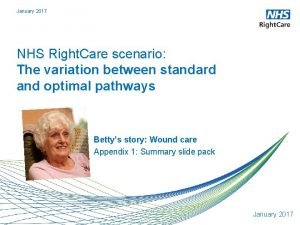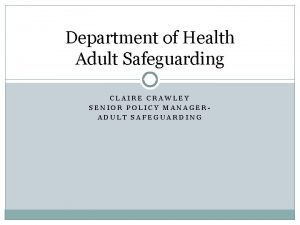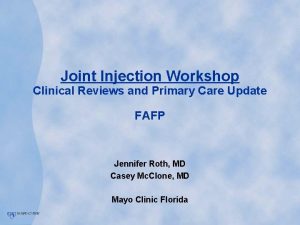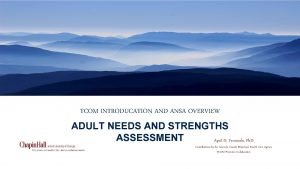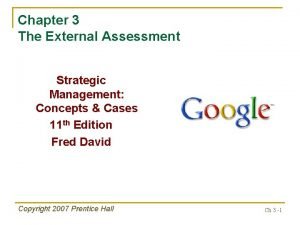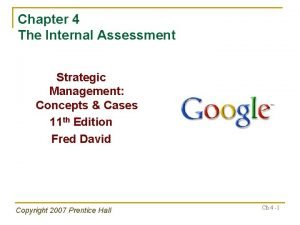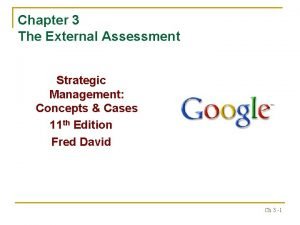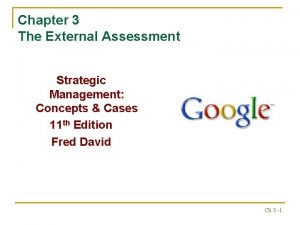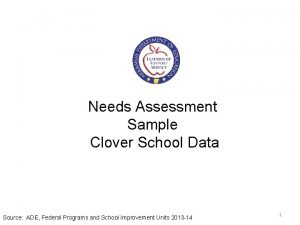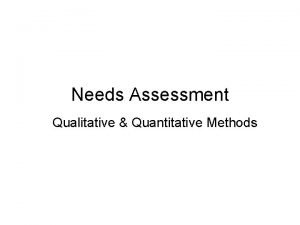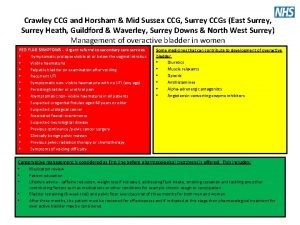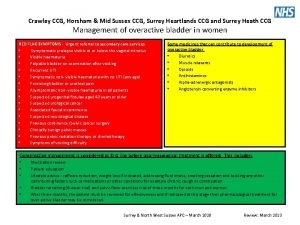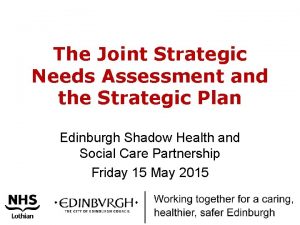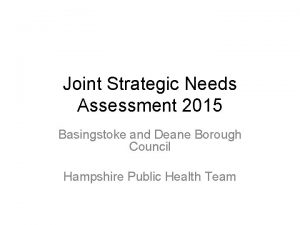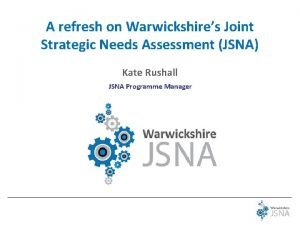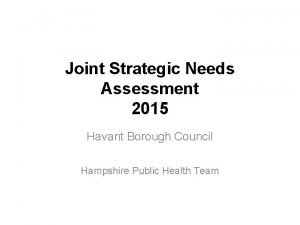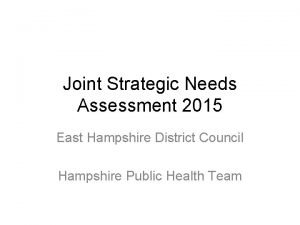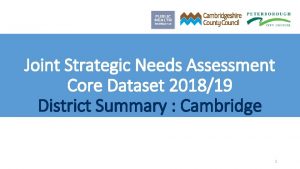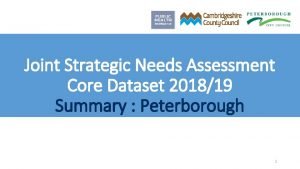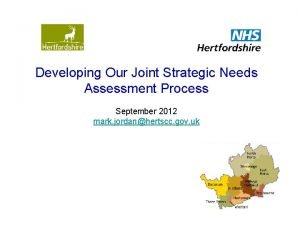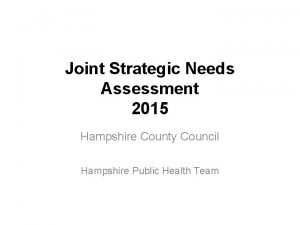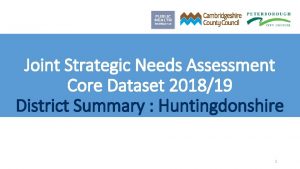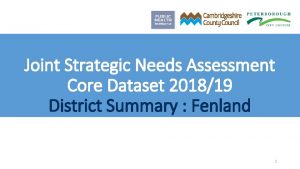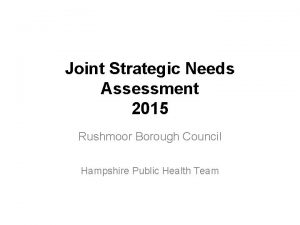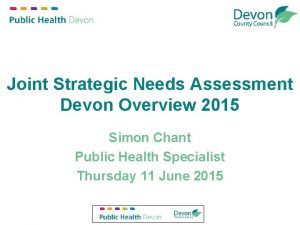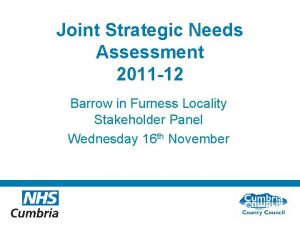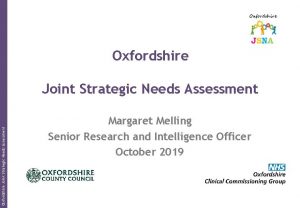Joint Strategic Needs Assessment Workshop Crawley and Horsham








































- Slides: 40

Joint Strategic Needs Assessment Workshop Crawley and Horsham & Mid Sussex CCGs May 2012 Catherine Scott Consultant in Public Health

Aims of workshop • Share information on health needs of the population • Identify key priorities for each locality to inform commissioning intentions 2012/13 • Identify areas where the JSNA needs to be developed to support CCGs • JSNA document for each CCG to be used for authorisation process

The process of Joint Strategic Needs Assessment (JSNA)

JSNA – what it is • The overarching primary evidence base on factors that influence the health of a population including the social, environmental, economic determinants of health • Support for decision making – – What are the gaps? What evidence is there that we could do better? What do we want to achieve? What are the most effective and cost effective interventions? • A dynamic and flexible process • A range of products IDEA

Why do we need it? • Statutory responsibility for CCGs and LAs • Demand is not the same as need • Partnership working is the only way to address some issues • A single agreed picture of needs is essential for strategic planning

JSNA framework • Data collection – – Routine data Local research eg surveys Professional views Public/patient views • Data analysis – – – – Ad hoc query based analysis Surveillance for unexpected Modelling Area based analysis Benchmarking Evaluation Cost benefit analysis • Interpretation in context – Statistical and methodological issues – Evidence from research – Experience of practice – Local knowledge – National policy • Communication – – Website Reports Presentations Briefings

What do we need to know? • What are the outcomes and why? • What do we expect to happen in future? • What evidence is there that we could achieve better outcomes? • What evidence is there that we could commission more effective and/or cost effective services without getting poorer outcomes? • If we change one part of the system what impact will it have?

High level priorities for West Sussex • Children and families – Child poverty – Education • Working age – Cardiovascular disease – Fair employment • Older people – Independence/Frail elderly – Dementia • Cross cutting issues – – – Inequalities Housing Early intervention Carers Ageing population Mental health

The population

Definitions Registered population Resident population (June 2011) (2010 mid year estimates) Crawley 123, 900 107, 600 Horsham & Mid Sx 223, 200 212, 235

High level health outcomes

Trend in male life expectancy 1991 -2010

Trend in female life expectancy 1991 -2010

Disability Free Life Expectancy Males Females Life expectancy at birth (years) Disability free life expectancy at birth (years) % without disability Life expectancy at birth (years) Disability free life expectancy at birth (years) Crawley 78. 6 72. 4 92. 1% 80. 6 73. 0 90. 6% Horsham 78. 6 74. 1 94. 3% 82. 7 77. 0 93. 1% Mid Sussex 78. 0 73. 5 94. 2% 81. 4 75. 9 93. 2% % without disability


Main causes of morbidity in males: UK 2004 : DALYs

Main causes of morbidity in females: UK 2004 : DALYs

All Deaths (2011) Crawley and Horsham & Mid Sx CCGs

Registered population structure June 2011 Crawley Horsham and Mid Sx

AGE - Actual and projected TFR, UK, 1951 - 2031 Unprecedented growth post-war to mid 1960 s Huge fall afterwards, many baby boomers not having children themselves, increases in recent years (Slide from ONS)

Births 2008 2009 2010 Mother aged <20 % low birth weight % BME mother Crawley 1, 529 1, 579 1, 727 75 8. 3% 41% Horsham & Mid Sx 2, 369 2, 311 2, 327 69 5. 7% 20% Registered population

Behavioural risk factors

‘Most non-communicable diseases are strongly associated and causally linked with four behaviours: tobacco use, unhealthy diet, physical inactivity and the harmful use of tobacco. ’ - WHO 2010

Behavioural risk factors for non-communicable diseases in order of importance Behaviour DALYS (000 s) Tobacco use 5, 526 Alcohol use 3, 165 Physical inactivity 2, 189 Low fruit & veg intake High income European countries, WHO 2009 547

Smoking rates 2009 -11

Admissions for alcohol-attributable conditions 2008/9 -2011/12 Rate per 100, 000 LA boundaries

Emergency admissions with a direct link to alcohol Number Total Cost Rate/1, 000 reg pop £/1, 000 reg pop Crawley 211 £ 263, 051 1. 92 £ 2, 397 Horsham 124 £ 172, 399 1. 62 £ 2, 256 Mid Sx 236 £ 180, 825 1. 77 £ 1, 353 North 571 £ 616, 275 1. 79 £ 1, 927

Metabolic/physiological changes

‘These behaviours lead to four metabolic/physiological changes: hypertension, overweight/obesity, hyperglycaemia and hyperlipidaemia. ’ - WHO 2010

Metabolic/physiological risk factors for non-communicable diseases in order of importance DALYs (000 s) High blood pressure 3, 807 Overweight & obesity 3, 132 High blood glucose 3, 208 High cholesterol 1, 859 High income European countries, WHO 2009

Diabetes: what evidence is there that we can do better?

Prevalence expected to increase by 12, 000 over next 20 years in West Sussex

Diabetes: QOF prevalence as a % of modelled prevalence

National Diabetes Audit 2010

DM 28 The percentage of patients with diabetes in whom the last IFCC-Hb. A 1 c is <=75 mmol/mol (9%) QMAS 2011/12

Diabetes: emergency admissions: Rate/1, 000 QOF registered patients: 2011/12

Diabetes patients experiencing any medication errors: RSCH 2011 (50% of 26 patients) Source: National Diabetes Inpatient Audit 2012

Diabetes patients experiencing any medication errors: Sa. SH 2011 (32% of 68 patients) Source: National Diabetes Inpatient Audit 2012

Evidence-based actions for CCGs on diabetes 1. Set targets to tackle risk factors in primary care to reduce future prevalence (eg brief interventions, referral to weight management services, Health Checks) 2. Local audits of patients receiving all 9 care processes with defined standards 3. Improve hospital care by specifying in contracts that diabetes care should be delivered by appropriately trained professionals 4. Local audits of medication errors in Sa. SH and BSUH 5. Clarify local costs of treating patients with diabetes and consider whether they can be reduced without compromising outcomes 6. Ensure patients receive education and support to manage their condition effectively 7. Systematically seek patient views to ensure services (primary, community and secondary care) are accessible, culturally appropriate and acceptable

Questions to consider • • • • What needs to change, and is it something we control, something we can influence, or something we can do nothing about? What outcome do we want? Is it an important health issue (mortality, morbidity, quality of life)? Will it have a big effect on a few or a small effect on many? Does an adequate treatment/pathway already exist? What’s the level of public/patient support? Will healthcare colleagues and partners support it? What impact will it have on inequalities? How quickly will we see the benefit? Do we know what to do (evidence base) or are we innovating? If we’re innovating how soon will we know whether it’s worked? And what would be the consequences of failure? Is it a national priority? Is it cost saving, cost neutral or cost effective? What’s the opportunity cost?
 Strategic gender needs and practical gender needs
Strategic gender needs and practical gender needs Saxon weald horsham
Saxon weald horsham Hatboro horsham wrestling
Hatboro horsham wrestling Aquafit classes horsham
Aquafit classes horsham Crawley vs rex
Crawley vs rex Tex bus
Tex bus Claire crawley
Claire crawley Primary needs and secondary needs
Primary needs and secondary needs Satisfaction
Satisfaction Primary needs and secondary needs
Primary needs and secondary needs Learning situation analysis
Learning situation analysis Semi permanent joining methods
Semi permanent joining methods Symphyses
Symphyses Joint injection crestview
Joint injection crestview Strategic planning workshop exercises
Strategic planning workshop exercises Visual planning definition
Visual planning definition Strategic planning workshop greater manchester
Strategic planning workshop greater manchester Strategic substitutes
Strategic substitutes Strategic management and strategic competitiveness
Strategic management and strategic competitiveness Tows matrix
Tows matrix Adult needs and strengths assessment
Adult needs and strengths assessment Damage assessment and needs analysis
Damage assessment and needs analysis Break joint lamb
Break joint lamb Ligamentum nuchae
Ligamentum nuchae Joint venture account is a
Joint venture account is a Lamb carcass grading
Lamb carcass grading Joint strategic planning system
Joint strategic planning system Strategic fit vs strategic intent
Strategic fit vs strategic intent The external assessment
The external assessment Internal assessment strategic management
Internal assessment strategic management Internal and external assessment in strategic management
Internal and external assessment in strategic management Competition in virtually all industries is
Competition in virtually all industries is Efe matrix of apple
Efe matrix of apple Internal and external assessment in strategic management
Internal and external assessment in strategic management Internal and external assessment in strategic management
Internal and external assessment in strategic management Chapter 3 strategic management
Chapter 3 strategic management The external assessment of strategic management
The external assessment of strategic management Ade needs assessment
Ade needs assessment Qualitative needs
Qualitative needs Community needs assessment steps
Community needs assessment steps Challenges of needs assessment
Challenges of needs assessment



